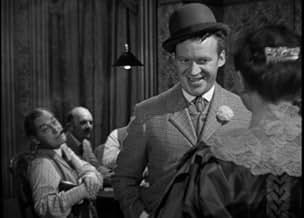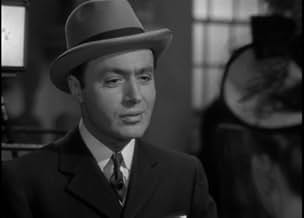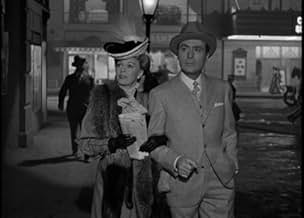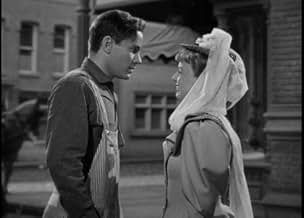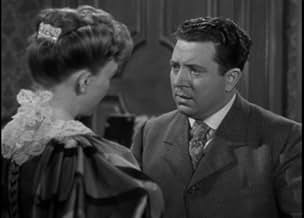Füge eine Handlung in deiner Sprache hinzuFive years after meeting and falling in love with a banker, a willful shop girl decides to become his mistress upon learning he has since gotten married and had a son.Five years after meeting and falling in love with a banker, a willful shop girl decides to become his mistress upon learning he has since gotten married and had a son.Five years after meeting and falling in love with a banker, a willful shop girl decides to become his mistress upon learning he has since gotten married and had a son.
- Regie
- Drehbuch
- Hauptbesetzung
- Für 1 Oscar nominiert
- 3 Gewinne & 1 Nominierung insgesamt
Eddie Acuff
- Andy
- (Nicht genannt)
Dorothy Adams
- Mrs. Brown
- (Nicht genannt)
William Alston
- Reporter
- (Nicht genannt)
Empfohlene Bewertungen
Margaret Sullavan is one of my all-time favorite actresses with her husky voice and haunting screen presence. The original version in 1932 with Irene Dunne and John Boles was dull and stage-bound; the later version with Susan Hayward was just too gaudy. This is the version to watch!
Margaret gives an exquisitely heart-rending performance as a turn-of-the-century miss who falls in love with a man (played by the smooth but oh-so-serious Charles Boyer). Fate intervenes and the two lovers are separated. They meet again years later, but, true to the classic weeper formula, he is married. Despite her better judgment, she carries on a "Back Street" romance with him for many years until their untimely demises.
Promoted with the tag line, "If you have tears, be prepared to shed them", this movie does involve some suspension of disbelief. For example, for such a level-headed gal, why does Margaret allow Boyer to treat her so shabbily? Just when I am about to shake my head and yell "Why?", Margaret then either let loose with the tears or try to hide the choking sob in her voice, and I'm transfixed all over again.
This film does feature solid direction, beautiful photography and some good supporting performances (I particularly liked Frank McHugh in this one). This film remains on my "Wish-They-Release-This-One-on-Video" list.
Margaret gives an exquisitely heart-rending performance as a turn-of-the-century miss who falls in love with a man (played by the smooth but oh-so-serious Charles Boyer). Fate intervenes and the two lovers are separated. They meet again years later, but, true to the classic weeper formula, he is married. Despite her better judgment, she carries on a "Back Street" romance with him for many years until their untimely demises.
Promoted with the tag line, "If you have tears, be prepared to shed them", this movie does involve some suspension of disbelief. For example, for such a level-headed gal, why does Margaret allow Boyer to treat her so shabbily? Just when I am about to shake my head and yell "Why?", Margaret then either let loose with the tears or try to hide the choking sob in her voice, and I'm transfixed all over again.
This film does feature solid direction, beautiful photography and some good supporting performances (I particularly liked Frank McHugh in this one). This film remains on my "Wish-They-Release-This-One-on-Video" list.
the flavor from a lost period and manner to discover/invent reality, Charles Boyer in his classic character clothes,Margaret Sullavan looks, the drops of romance and drama, the pink crumbs and a decent acting are the pillars of that version. a version from the middle of war who use in smart manner the hope, love and a sentimental affair.maybe, it is not the best version. but it has a perfect cast for translate the story in right sentimental tone. that fact is really important because it reminds the flavor of a world. and the result is a kind of gem. not very precious, not exactly unique but nice at whole. a film for rainy afternoons and Sunday evening. like an old love song.
This second version of Back Street stars Margaret Sullavan as the Fannie Hurst
heroine who contents herself with being a mistress to a well known and rich
business executive. She has a few chances at marriage with others but this
woman won't settle for what she considers second best.
Margaret Sullavan had that tragic quality to her that made her cast so well in these parts. She had an unusual amount of screen deaths among her films like Three Comrades and No Sad Songs For Me. In this one she chooses what amounts to a living death with only moments of happiness.
It was a chance meeting at a railroad station that she meets up and coming business executive Charles Boyer. Boyer's French accent is explained by saying he was originally from New Orleans. Boyer too was born for romantic parts and he had just come off films like Algiers, Love Story, Hold Back The Dawn and All This And Heaven Too. Anoher player born for romance, happy or tragic.
It's a moment of capricious fate arranged by one of Sullavan's male acquaintances Frank Jenks that keeps them apart as she misses a riverboat that she was to leave on with Boyer. The next time they meet Boyer is married, but she agrees to be his mistress she loves him so.
Noting some other fine performances in this version are Esther Dale as Sullavan's stepmother, Frank McHugh as a traveling salesman who introduces Boyer and Sullavan, Richard Carlson as another male acquaintance whose proposal she turns down and who makes a fortune in the up and coming automobile business Samuel S. Hinds as Boyer's father-in-law.
Three of Hollywood's best actresses have played Ray Smith. In order Irene Dunne, Margaret Sullavan and Susan Hayward. Who was best in the role who can say. But I wouldn't want to bet money on a contest poll on any of them. Ray Smith is a choice female role and three choice players have done it.
Margaret Sullavan had that tragic quality to her that made her cast so well in these parts. She had an unusual amount of screen deaths among her films like Three Comrades and No Sad Songs For Me. In this one she chooses what amounts to a living death with only moments of happiness.
It was a chance meeting at a railroad station that she meets up and coming business executive Charles Boyer. Boyer's French accent is explained by saying he was originally from New Orleans. Boyer too was born for romantic parts and he had just come off films like Algiers, Love Story, Hold Back The Dawn and All This And Heaven Too. Anoher player born for romance, happy or tragic.
It's a moment of capricious fate arranged by one of Sullavan's male acquaintances Frank Jenks that keeps them apart as she misses a riverboat that she was to leave on with Boyer. The next time they meet Boyer is married, but she agrees to be his mistress she loves him so.
Noting some other fine performances in this version are Esther Dale as Sullavan's stepmother, Frank McHugh as a traveling salesman who introduces Boyer and Sullavan, Richard Carlson as another male acquaintance whose proposal she turns down and who makes a fortune in the up and coming automobile business Samuel S. Hinds as Boyer's father-in-law.
Three of Hollywood's best actresses have played Ray Smith. In order Irene Dunne, Margaret Sullavan and Susan Hayward. Who was best in the role who can say. But I wouldn't want to bet money on a contest poll on any of them. Ray Smith is a choice female role and three choice players have done it.
Two of Hollywood's greatest actors, Charles Boyer and Margaret Sullavan, starred in this first remake of the 30s tearjerker, and they
portrayed the star-crossed lovers with great restraint. Acting, writing and direction all combined to create the ultimate BACK STREET! Warners had their crime dramas, MGM had their musicals, Paramount had their comedies, and Universal had the best weepers. This may be the very best one ever! Even the supporting cast was hand-picked with care. Richard Carlson, ever the "other guy", does his thing once more, and we want him to win for a change, but in this case, true love ruins all. Frank McHugh, as Rae's friend, gives perhaps his best performance.
portrayed the star-crossed lovers with great restraint. Acting, writing and direction all combined to create the ultimate BACK STREET! Warners had their crime dramas, MGM had their musicals, Paramount had their comedies, and Universal had the best weepers. This may be the very best one ever! Even the supporting cast was hand-picked with care. Richard Carlson, ever the "other guy", does his thing once more, and we want him to win for a change, but in this case, true love ruins all. Frank McHugh, as Rae's friend, gives perhaps his best performance.
This is the second of the thrice filmed Fanny Hurst novel about the other woman. Tastefully directed and lensed by Robert Stephenson and Charles Daniels and featuring standout performances from Charles Boyer and Margaret Sullavan it is probably the best of the bunch.
Traveling salesman Walter Saxel and free spirit Ray Smith meet through an acquaintance and in the course of an evening become strongly attracted to each other. He is engaged but makes a decision to marry her on board a river boat. She unfortunately misses the boat and Saxel doesn't see her for another five years marrying in the meantime. They rekindle and she becomes his mistress. As he grows in fame and fortune she remains in the shadow for decades until his children confront her.
Boyer and Sullavan as the long time lovers display a wonderful chemistry with each other. Sullavan's husky voice and Boyer's suave inflection reinforced by telling glances unite the two in an odd but perfect romantic match. Richard Carlson as a well intentioned suitor is also well cast and Frank McHugh, allowed to stretch, shines as Ray's loyal friend with an eternal crush.
Director Stephenson does an excellent job of keeping mood subdued without resorting to hysterics to bring life to the story. His adults behaving like adults expressing and suppressing their feelings in a tempered but passionate way gives the film a graceful tension. Cinematographer Charles Daniels turns in his usual array of impeccably lit compositions such as an evening snowfall where Ray and Walter meet for the first time in five years and the powerful final moments that he along with Stephens jarring and effectively de-romanticizes with stunning portraiture that evokes Goya.
Traveling salesman Walter Saxel and free spirit Ray Smith meet through an acquaintance and in the course of an evening become strongly attracted to each other. He is engaged but makes a decision to marry her on board a river boat. She unfortunately misses the boat and Saxel doesn't see her for another five years marrying in the meantime. They rekindle and she becomes his mistress. As he grows in fame and fortune she remains in the shadow for decades until his children confront her.
Boyer and Sullavan as the long time lovers display a wonderful chemistry with each other. Sullavan's husky voice and Boyer's suave inflection reinforced by telling glances unite the two in an odd but perfect romantic match. Richard Carlson as a well intentioned suitor is also well cast and Frank McHugh, allowed to stretch, shines as Ray's loyal friend with an eternal crush.
Director Stephenson does an excellent job of keeping mood subdued without resorting to hysterics to bring life to the story. His adults behaving like adults expressing and suppressing their feelings in a tempered but passionate way gives the film a graceful tension. Cinematographer Charles Daniels turns in his usual array of impeccably lit compositions such as an evening snowfall where Ray and Walter meet for the first time in five years and the powerful final moments that he along with Stephens jarring and effectively de-romanticizes with stunning portraiture that evokes Goya.
Wusstest du schon
- WissenswertesA contemporary article in the Los Angeles Examiner stated Joan Fontaine was originally cast in the female lead, but she was replaced by Margaret Sullavan before shooting began.
- PatzerIn the closing sequences, which are supposed to be taking place in 1928, all of the women's hair styles and clothes, particularly those of Nell O'Day, and especially Margaret Sullavan's square-shouldered fur cape, are strictly contemporary 1941.
- VerbindungenFeatured in Die Universal-Story (1996)
- SoundtracksAuld Lang Syne
(uncredited)
Traditional Scottish music
Lyrics by Robert Burns
Sung by New Year's Eve party revellers
Top-Auswahl
Melde dich zum Bewerten an und greife auf die Watchlist für personalisierte Empfehlungen zu.
- How long is Back Street?Powered by Alexa
Details
- Erscheinungsdatum
- Herkunftsland
- Sprache
- Auch bekannt als
- Fanny Hurst's Back Street
- Drehorte
- Produktionsfirma
- Weitere beteiligte Unternehmen bei IMDbPro anzeigen
- Laufzeit1 Stunde 29 Minuten
- Farbe
- Seitenverhältnis
- 1.37 : 1
Zu dieser Seite beitragen
Bearbeitung vorschlagen oder fehlenden Inhalt hinzufügen


